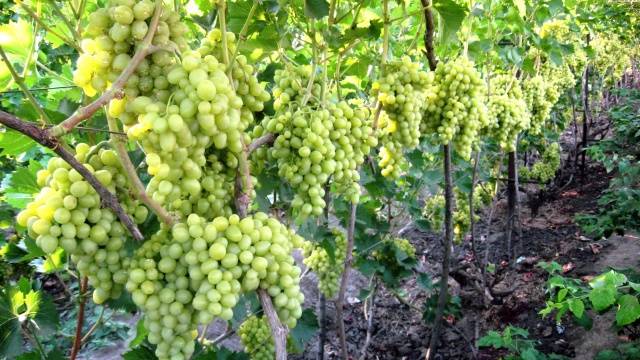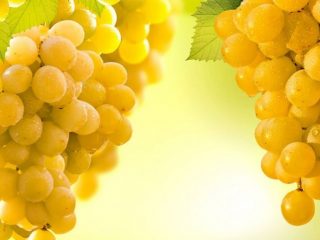Content
From the huge variety of grape varieties, every gardener strives to choose the one that best suits his requirements. Often it turns out to be a variety or hybrid form of amateur selection. These include Vanyusha grapes, a description of the variety and photos of which are presented below.
Description
Table grapes with the affectionate name Vanyusha are the creation of the national breeder V. N. Krainov. This is a hybrid form with light colored berries, the result of crossing two time-tested varieties Talisman and Radiant Kishmish. Grapes ripen early; in the southern regions of Russia, the first harvest is ready for harvest in the first ten days of August; grapes can be harvested en masse in the 2-3 ten days of the month. In the Middle Zone, its clusters ripen later, so in these regions it is considered mid-early or medium.
Description of the Vanyusha grape variety and its photo:
- the bush stands out for its powerful and rapid growth;
- leaves are large, carved, intense green in color with lighter veins;
- flowers are bisexual, grapes bloom in the 1st-2nd decade of June;
- the clusters are large, elongated, wide-conical, each weighs 0.9-1.5 kg (maximum 2 kg);
- the brush is medium dense or slightly loose;
- berries are large, oval-round, weighing 12-18 g;
- the skin is medium-dense, its color is delicate yellow-green; when the berries are fully ripe, they are the same amber-yellow with a pinkish tint;
- on the same bunch of berries can vary in size and taste;
- the pulp is medium-dense, juicy and fleshy, having a pleasant sweet taste with a slight sourness;
- taste and aroma – light nutmeg.
The berries of the Vanyusha grape variety accumulate sugar well, do not rot, do not crack, and do not bake in the sun. The bunches can hang on the vine for a long time (up to 1 month) after they are fully ripe. After this, their taste does not change for the worse, but only improves, the nutmeg notes in it become brighter. Due to the rather dense skin, Vanyusha grapes can be transported over long distances. It can be eaten fresh and can also be used to make desserts.
Characteristics
With proper agricultural technology and careful care, Vanyusha grapes, according to winegrowers, are capable of producing generous harvests every year. The load on the bush should be on average 30-35 eyes. You need to increase it gradually, starting from 2-3 years, and make sure not to overload the bush. If this is not done, the berries will be small and their taste will decrease. In the first 2 years, only 1-3 brushes are allowed. It is also necessary to thin out growing shoots in a timely manner. The shoots of this variety ripen by the time of autumn pruning to 2/3 of their length.
The hybrid form of the Vanyusha grape is characterized by excellent rooting of cuttings (almost 100%), good ripening and survival in a permanent place. In this regard, it has fewer problems arising after transplantation and with reproduction than other varieties.
Frost resistance of Vanyusha grapes, according to the description of the variety, is up to – 20-23°C.This suggests that in cold regions the bushes will have to be covered for the winter. In the south you can do without this labor-intensive event.
The bush bears fruit consistently, and its yield is considered high - from a young bush you can collect 6 kg of berries, from an adult, subject to the rules of agricultural technology and shaping - up to 14 kg of good presentation and quality of bunches.
Flaws
In cold, rainy weather, grape flowers are poorly pollinated, so in the future, shedding of the ovary and peas may occur: defective small seedless berries appear in the cluster.
Another drawback of the variety is that if harvested untimely, the grapes become overripe and fall off, which affects the amount of harvest.
Diseases and their prevention
The resistance of Vanyusha grapes to the main diseases of the grapevine - mildew, oidium, gray rot - is average or above average (2.5-3 points). To protect bushes from them, the following preventive measures are required:
- Regular pruning of grapes in autumn or spring. For this variety, pruning with 9-10 eyes is recommended. It is necessary to remove all weak, damaged, dry shoots.
- Thinning out excess green shoots for normal ventilation of the bush.
- Timely repeated treatment of grapevines against common diseases and pests with fungicides, insecticides and acaricides.
- Feeding the bush with mineral or organic fertilizers.
- Cleaning and destruction of plant debris - leaves, cut twigs and fallen berries.They can be burned or added to the compost pile.
- Digging the soil around the bush, which is carried out so that it freezes well in winter.
The implementation of such agricultural practices must be approached responsibly, because the health of the bush depends on how the gardener treats his responsibilities.
Planting a seedling and caring for it
The easiest way to propagate Vanyusha grapes is by cuttings. Almost all of them take root both during autumn and spring planting. For the seedling, you need to choose a bright place, well lit by the sun, well ventilated, but without blowing winds or drafts. Planting in a shaded area reduces the bush's resistance to diseases. Low-lying areas with close groundwater are not suitable for grapes. The soil for it should be fertile, light, air and moisture permeable. Cultivated sandy loams and loams are best suited for this.
The plant can be planted both in open areas by building a classic trellis for it, and near buildings, for example, as in this photo.
Sequence of planting Vanyusha grape seedlings:
- Dig a hole 0.7-0.8 m in length, width and depth.
- Place a layer of drainage material at the bottom - broken bricks, small pieces of slate, small stones.
- Sprinkle a mixture of garden soil, compost, sand and ash on top.
- Water the soil and wait for the water to settle.
- Plant a seedling in the hole, cover it with soil and compact it well.
- Mulch the soil with straw, old hay, last year's unrotted leaves, sawdust, or cover it with film (agrofibre).
- If planting is carried out in the fall, before the cold weather sets in, the seedling should be covered for the winter with thick covering material or sprinkled with earth.
The feeding area per bush should be at least 4-6 square meters.m, so the next seedling needs to be placed taking this into account.
You need to water the seedling until it takes root every 2 weeks, pouring 2-3 buckets of water under it. There is no need to feed the young bush with anything in the first 1-2 years. In the fall it must be covered, even if the winter is not cold.
Caring for an adult bush
The formed Vanyusha grape bush needs to be watered 3-5 times during the growing season:
- After a winter with little snow - even before the buds open. If there is enough moisture in the soil, then this watering can be skipped.
- A couple of weeks before flowering.
- After the formation of the ovaries.
- 3 weeks before the berries ripen.
- In dry, warm autumn - immediately after the leaves fall. In rainy weather, water-recharging irrigation may not be carried out.
Watering rates are at least 50-70 liters per bush. It is advisable to pour water not at the root, but at some distance from it. After the next watering or rain, the soil under the plant must be loosened.
It is necessary to fertilize Vanyusha grapes 3-4 times per season with mineral fertilizers. Do the first fertilizing before flowering, use nitrogen fertilizers, the next fertilizing with phosphorus and potassium - after 1 month. Fertilizers of organic origin (compost, ash and humus) are applied after 2 seasons at a dose of 10-15 kg per bush. Microelements are also useful: magnesium, zinc, boron.
You can form a Vanyusha grape bush according to the diagram in the photo.
The main pruning should be done in the fall (on mature bushes) or in the spring (on young bushes), in the summer - cut out excess green shoots, leaving 22-24 pcs. It is recommended to trim the fruiting shoots of this vigorous grape into 8-10 buds.In addition to pruning and thinning the shoots, Vanyusha grapes require tying up fruit-bearing branches, as they have heavy and large clusters.
You can begin harvesting when the berries in the clusters reach technical ripeness. Such grapes are already sweet and juicy, but still dense, do not crumble, and can be transported for sale or stored in a cool, dark place. For quick consumption, you can leave the bunches to ripen on the bush. When biologically ripe, Vanyusha grapes are most delicious. However, it is better not to delay harvesting, since when overripe the berries often fall off, although the bunches retain their presentation for quite a long time. You need to cut the bunches with pruning shears, putting them in baskets in small batches. Then use it for its intended purpose.
Reviews
Conclusion
The hybrid form of Vanyusha grapes is a successful combination of early ripening, productivity and excellent commercial and taste qualities. Caring for it is standard and simple, and the harvest is guaranteed. Plant it in your plots to always have tasty and beautiful-looking white grapes on your table.














